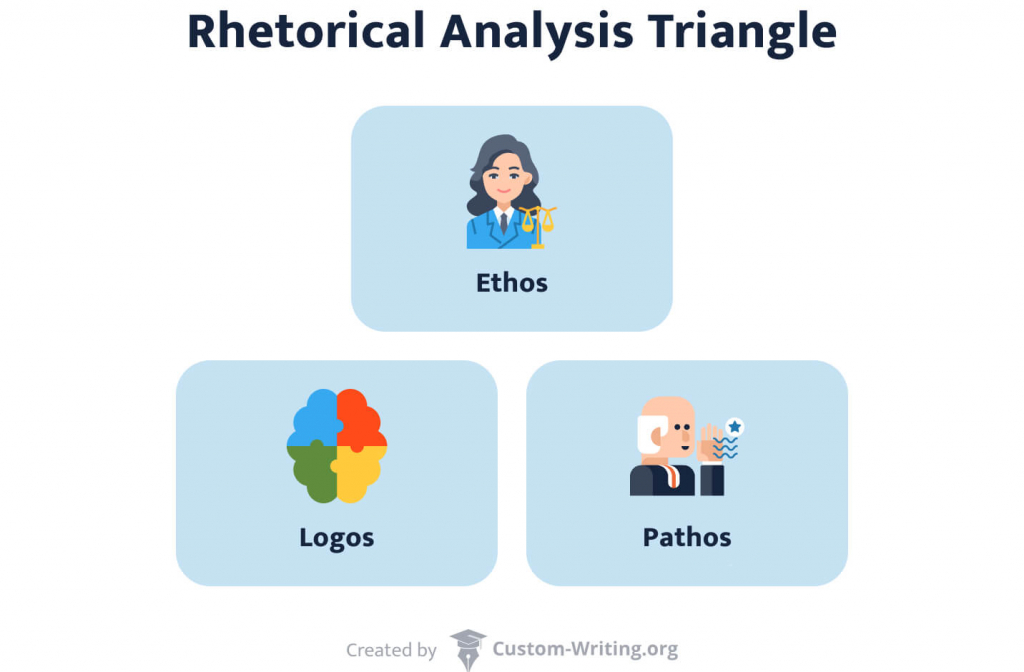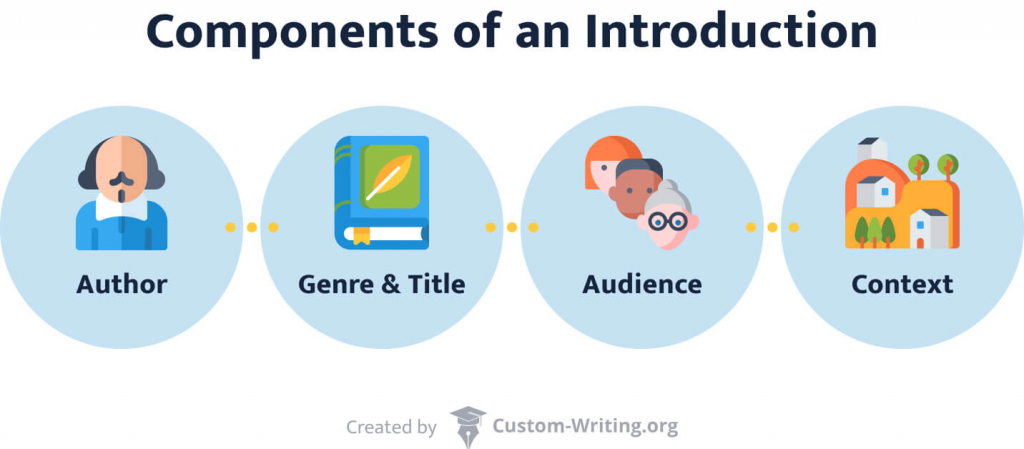A rhetorical analysis essay outline is a structured plan that helps organize ideas and arguments when analyzing how an author uses rhetorical devices and strategies in a text. It breaks down the components of the essay to ensure a logical flow and thorough interpretation of the material. Whether you’re prepping for an AP Lang exam or working on a college assignment, having a detailed rhetorical essay outline will save you time and make your writing process much simpler.
In this article by our custom writing team, you’ll find:
- Tips on how to prepare for writing a rhetorical analysis
- Step-by-step guidance for creating a coherent rhetorical analysis outline
- Helpful examples and engaging essay topics
- A downloadable rhetorical analysis template in which you can simply fill in the blank spaces to craft a polished outline
Read on to make your rhetorical analysis focused and well-organized right from the start.
📚 Structure of a Rhetorical Analysis Essay: Pre-Writing
The first thing you need to know about the task is that the analysis in your paper is strictly rhetorical. In other words, you don’t need to discuss what the author is saying. Instead, it’s a take on how the author expresses it.
And to understand “how,” you need to find rhetorical appeals. An appeal is a technique that the author uses to convince the reader. The main ones are logos, ethos, and pathos.

The whole analysis is structured around them and divided into 3 parts: appeals in the text’s introduction, in the body paragraphs, and in its conclusion.
Remember that it’s essential to structure your essay in chronological order. To put it simply, it’s better not to review the appeals from the conclusion before the ones in the introduction. Follow the structure of the text you’re analyzing, and you’ll nail it.
Rhetorical Analysis Triangle
We’ve already mentioned ethos, pathos, and logos. The rhetorical triangle is another name for these 3 main appeals. Let’s examine them in more detail:
- Logos is the appeal of rationality. It includes the usage of argumentation, citing statistics, and referring to facts. You will see a lot of logos in academic writing.
- Ethos (also known as the ethical appeal) aims to convince the reader by taking the authority high ground. For example, authors may demonstrate how skillful or knowledgeable they are in the discussed field to make their claims more impressive.
- Pathos appeals to the reader’s emotions. You can do it by revealing a shocking fact or delivering inspirational statements. Inducing anger, pity, or any other positive or negative emotion counts as pathos.
In your essay, it’s best to examine all 3 appeals. It’s also necessary to measure their effectiveness and give examples. A good strategy is to find the appeals in the text, underline them, and analyze them before writing the outline.
Each appeal can be characterized by the following:
- Diction. Diction is the wording that the author uses to describe the idea. When analyzing diction, you want to find words that stand out in the text.
- Syntax. Simply put, syntax is the order of words used by the author. You can also look at the sentence length as a part of the syntax.
- Punctuation. This characteristic is all about the usage of punctuation marks. Aside from commas, it’s good to pay attention to colons and dashes. Authors can use them to focus the audience’s attention on something or create a dramatic disjunction.
- Tone. It’s the author’s attitude towards the discussed idea. The tone is a combination of diction, syntax, and punctuation. For example, you can tell if the author is interested or not by evaluating the length of sentences.
Remember that all 3 appeals are artistic proofs, and you shouldn’t confuse them with factual evidence. The difference between them lies in the amount of effort:
- Citing factual evidence requires no skill. You create proof just by mentioning the fact.
- In the case of artistic proof, you must use your knowledge of rhetoric to create it.
What Is Kairos in Rhetorical Analysis?
Kairos is the timeliness of the argument. It is the appeal of the right time. The usage of kairos usually means that the author’s text is relevant for a certain period of time only.
SOAPS: Rhetorical Analysis
SOAPS is a helpful technique for analyzing texts rhetorically. It’s fairly popular and is recommended for AP tests. SOAPS stands for:
- Subject (What is the idea of the text?)
- Occasion (What prompted the author to write the text?)
- Audience (Who would find the text interesting?)
- Purpose (What did the author write it for?)
- Speaker’s characteristics (What is the author’s personality?)
Answering the questions above will make it easy for you to find the necessary appeals.
✍️ How to Write an Outline for a Rhetorical Analysis Essay
Now that you’ve found the appeals and analyzed them, it’s time to write the outline. We will explain it part by part, starting with the introduction.
How to Write an Introduction for a Rhetorical Analysis Essay
In a rhetorical analysis, the introduction differs from that of a regular essay. It starts by covering all the necessary information about the work’s author:
- Name (or names, if there are several authors).
- Genre and title of the reviewed work.
Example:
The author claims that cats are better pets than dogs.
- The target audience that the writer is aiming at.
- The context in which the text was produced, e.g. a specific event.

Aside from that, a rhetorical essay introduction should include a hook and a thesis statement. Want to know how to write them? Keep reading!
How to Write a Hook for a Rhetorical Analysis Essay
A hook is a sentence that seizes the reader’s attention. You can achieve it by presenting a curious fact about the author. You might also use an inspiring or amusing quote. Make sure your hook is connected with the text you are writing about.
For example, if you’re analyzing MLK’s I Have a Dream speech, you can hook the audience with the following sentence:
Example:
Martin Luther King is widely considered the most famous speaker in history.
Our article on hooks in writing can provide you with numerous great ideas.
Thesis Statement for Rhetorical Analysis Essay
In a rhetorical analysis essay, you don’t need to create a thesis statement in the usual sense. Instead, you describe the main point made by the author using a rhetorically accurate verb (such as “claims” or “asserts”) followed by a “that” clause.
For example, your thesis can focus on the techniques the speaker uses to convince the audience. If you examine the I Have a Dream speech, you will notice several stylistic elements:
- Metaphor
MLK describes the poor financial state of the black community as a “Lonely island of poverty.” - Repetition
King repeats the famous phrase “I have a dream” several times during the speech. - Symbolism
The speaker refers to the members of the Civil Rights Movement as “my people.”
It’s not a complete list, but that’s enough to form a decent thesis.
You also need to mention the ideas behind the speech. The main idea is, obviously, equality. So, put it in your thesis as well. As a result, you’ll have something like this:
Example:
Through the skillful usage of metaphor, repetition, and symbolism Martin Luther King effectively fills his audience’s hearts with the idea of unity and equality.
Rhetorical Analysis Body Paragraphs
If you are writing a generic 5-paragraph essay, you can divide your essay’s body into 3 parts:
- A paragraph about appeals in the text introduction.
- A section about rhetorical devices in the text’s body.
- A paragraph about rhetorical devices in the text’s conclusion.
Sometimes there is no distinct structure in a text. If that’s the case, just analyze the appeals in chronological order. You can also split the analysis based on the type of appeals. For example:
Example:
- A paragraph about emotional appeals.
- A section about logical appeals.
- A paragraph about ethical appeals.
Each of your essay’s body paragraphs should have 3 key elements:
- Topic sentence that shows what appeal you will discuss in the section.
- Examples that illustrate the rhetorical device you want to showcase.
- Your take on the effectiveness of the given device.
It’s good to remember that every appeal you talk about needs an example. If you can illustrate your claim about a strategy with more examples, then go for it. The more examples, the better.
Good Transition Words for Rhetorical Analysis Essay
Transition words allow you to follow up one idea with another. They also help build connections between paragraphs. Choosing correct transition words depends on the strategy you use. If you want to build a sequence of a cause and its effect, you will need words like “thus” or “hence.” If you’re going to clarify something, you should use a different set of words.
Here’s a list of helpful transition words suitable in different contexts:
- If you need to showcase an example: for example, to illustrate, in particular, for instance.
- If you need to supplement your information: actually, furthermore, also, besides, moreover, further, again, indeed.
- If you need to emphasize something: above all, undoubtedly, obviously, indeed, especially, surely.
- If you need to show a cause and its effect: therefore, as a consequence, for this reason, accordingly, as a result, thus, consequently.
Rhetorical Analysis Verbs to Use
A rhetorical analysis essay is a serious work that often touches on complex topics. Regular verbs like “tells us” or “shows” don’t always fit it. To make your paper more inclusive and precise, consider using strong verbs.
Strong verbs (or power verbs) are typically used when talking about the author. That includes their strategies, attitude, personality, or ideas.
For example, instead of “the author says,” you can use “suggests” or “clarifies,” depending on the context.
Some other rhetorically accurate verbs include:
- Suggests
- Hints
- Implies
- Questions
- Sheds light
- Clarifies
- Notes
- Observes
- Asserts
You don’t have to use strong verbs only. If you feel like “says” suits your point better than any strong verb, feel free to use it.
Rhetorical Analysis Essay Conclusion
The conclusion is the ending of your paper. It sums your essay up and underlines the points you’ve made in the body paragraphs. A good conclusion should accomplish several things:
- Paraphrasing the thesis. You shouldn’t just rewrite the thesis from the introduction. The restatement is usually used to demonstrate a deeper understanding of your point.
- A summary of the body paragraphs. Again, simple repetition is not enough. We need to link the points to our thesis and underline the importance of our statements.
- Final thoughts. A powerful epilogue will leave a good impression about your work.
Make sure to avoid including any new ideas or statements. The conclusion is exclusively for summarizing. If you found yourself putting a new assertion in the ending, it’s probably a good idea to restructure your body paragraphs.
📑 Rhetorical Analysis Essay Example Outline & Template
To make the writing process even easier for you, we will show you what an outline for your essay can look like. As an example, we will outline a rhetorical analysis of MLK’s I Have a Dream speech. We are going to structure it according to the appeals.
Have a look:
Example:
Introduction
- Hook. An interesting fact about the MLK or his quote. An emotional start about the importance and the lasting legacy of the speech will also work.
- Background information. All the necessary info about the author. That includes:
- The speaker’s name, occupation, and years of life.
- The context in which the subject of our essay was produced.
- The speech’s target audience.
- Thesis statement. Point out the appeals you are going to write about. Describe their impact on the author’s general argumentation.
Body paragraphs
- Paragraph 1. The emotional appeals in the speech. Mention the use of pathos.
- Underline the often use of metaphor. Set “lonely island of poverty” and “ocean of material prosperity” as examples.
- Talk about the usage of repetition. Use the constant repetition of “I have a dream…” as an illustration.
- Paragraph 2. The logos and ethos usage in the speech.
- Demonstrate the use of logos. Mention King citing President Lincoln as an authority for his argumentation.
- Showcase the ethos of the speech. Notice that MLK’s Civil Rights Movement logic correlates with social ethics at the time.
- Paragraph 3. The symbolism in the speech. Give several examples of symbolism and their rhetorical effects. Include the following examples:
- Comparing segregation to a “bad check.”
- Referring to the Civil Rights Movement as “my people.”
- Comparing the acquisition of equality to “cashing a check.”
Conclusion
- Restate the thesis. Demonstrate a deeper understanding of the point made in the introduction.
- Summary of the body paragraphs. Connect them to the thesis statement. Give a final take on King’s rhetorical strategies and evaluate their effectiveness.
- Closing thought. Finish by stating the primary goal of your analysis.
Alternatively, you can structure your essay in chronological order. Below you’ll find a template you can use for this type of rhetorical analysis. Simply download the PDF file below and fill in the blanks.
Example:
Rhetorical Analysis Outline Template
(your essay’s title)
Introduction.
The speaker/author is (state the author’s name.) The purpose of the text is to (state the text’s purpose.) The text is intended for (describe the text’s intended audience.)
Check out the rhetorical analysis samples below to get some ideas for your paper.
- Greta Thunberg’s Speech: Rhetorical Analysis
- Rhetorical Analysis: “In Defense of the ‘Impractical’ English Major” by C. Gregoire and “Top 10 Reasons You’re Not Wasting Your Time as an English Major” by S. Reeves
- Steve Jobs’ Commencement Speech Rhetorical Analysis
- The Speech “Beyond Vietnam: A Time to Break Silence” by Martin Luther King, Jr: Rhetorical Analysis
- Rhetorical Analysis Through Lyrics: “The Times They Are A-Changing” and “The Wind of Change”
- Roiphe’s Confessions of a Female Chauvinist Sow: Rhetorical Analysis
- “Snack Attack”: Rhetorical Analysis
- Rhetorical Analysis of “Hidden Intellectualism” by Gerald Graff
Rhetorical Analysis Essay Topics
- Analyze rhetorical appeals of a Hallmark’s commercial
- Rhetorical devices and the atmosphere of Hamlet’s To Be or Not to Be monologue
- The author’s argument in Us film
- Compare pathos, ethos, and logos in two advertisements
- Google Analytics: rhetorical analysis
- The background and the audience of the Gillette commercial short film
- Rhetorical analysis of capitalism and socialism
- What makes John F. Kennedy’s inaugural address iconic?
- The significance of the historical parallel in Susan B. Anthony’s speech
- Sarcasm and skepticism in Shikha Dalmia’s article
- Rhetorical analysis of political debates between Biden, Harris, and Booker
- What makes Letter From Birmingham Jail powerful?
- Problems of the modern education in Moore’s Idiot Nation and Gatto’s Against School
- Rhetorical techniques in Learning to Read and Write by Frederick Douglass
- Compare and contrast Antigone and Creon
- The word framing of Michelle Obama’s TED speech
- James Q. Wilson’s arguments on gun ownership laws
- Analyze ethos, pathos, and logos in a video advertisement
- What makes the 2005 speech by Steve Jobs remarkable?
- How does Jenna Berko convince readers in her essay?
- Successful persuasion in the film Henry V
- Margaret Fuller and Frederick Douglass: a rhetorical comparison
- Characters, setting, and emotions in Of Mice and Men
- Web blogs rhetorical analysis
- Rhetorical devices in Barbara Holland’s collection of thoughts
- Conduct a rhetorical analysis of Louis C. K.’s Shameless
- What makes Claire Giordano’s essay convincing?
- Biblical allusions in Narrative of the Life of Frederick Douglas
- Ali Siddiq’s ‘Prison Riot’ standup: a rhetorical analysis
- Presentation of interracial romance in Get Out movie
- Rhetoric Instruments in The Oxford Encyclopedia of Latinos and Latinas in the United States
- How does Barack Obama try to change reality with his speech?
- Target and purpose of L’Oréal EverCrème advertisement
- Perform a rhetorical analysis of Pop Can: Popular Culture in Canada
- The Myth of the Charioteer by Plato: rhetorical devices
- Rhetorical goals of the authors of African-American history articles
- The effectiveness of the Michelin advertising campaign
- Rhetorical analysis of the Double Cola Company’s image
- Compare the use of argument in Lincoln’s and Dickinson’s works
- Rhetoric analysis of anti-communist and anti-Islam promotion
We hope this article helped you with your assignment. Make sure to tell us what part helped you the most in the comments. And good luck with your studies!
Further reading:
- How to Write a Reflection Paper: Example & Tips
- How to Write a Narrative Essay Outline: Template & Examples
- What Is a Discourse Analysis Essay: Example & Guide
- How to Write a Critical Thinking Essay: Examples & Outline
- How to Write a Precis: Definition, Guide, & Examples
- How to Write a Process Analysis Essay: Examples & Outline
🔍 References
- Rhetorical Analysis: Miami University
- Rhetorical Analysis Essay: Formatting: California State University, East Bay
- The Rhetorical Triangle: Understanding and Using Logos, Ethos, and Pathos: Louisiana State University
- The Rhetorical Triangle: The University of North Carolina at Charlotte
- General Notes on Rhetorical Analysis: Deer Valley Unified School District
- SOAPS: Rhetorical Analysis of a Reading Source: Kent Campus
- How To Write a Rhetorical Analysis in 8 Simple Steps: Indeed
- Rhetorical Analysis: Texas A&M University
- Rhetorical Analysis Thesis Statements: Virginia Wesleyan University
- What Are Logos, Ethos, Pathos, and Kairos?: University of Louisville

![Critical Analysis Essay Example & Writing Guide [2026]](https://custom-writing.org/blog/wp-content/uploads/2021/10/business-men-sitting-lawyers-s-desk-people-signing-important-documents-284x153.jpg)


![Critical Writing: Examples & Brilliant Tips [2026]](https://custom-writing.org/blog/wp-content/uploads/2021/02/fingers-note-report-journalist-filling-284x153.jpg)





![How to Write an Argumentative Essay: 101 Guide [+ Examples]](https://custom-writing.org/blog/wp-content/uploads/2021/01/young-writer-taking-notes-284x153.jpg)
![How to Title an Essay: Examples & Step-by-Step Guide [2026]](https://custom-writing.org/blog/wp-content/uploads/2021/01/close-up-woman-making-greeting-card-new-year-christmas-2021-friends-family-scrap-booking-diy-writing-letter-with-best-wishes-design-her-homemade-card-holidays-celebration-284x153.jpg)
Extremely helpful. Gave me wonderful definitions of Pathos,Lagos and Ethos.Broke down how to use these points to write my analysis. Thank you